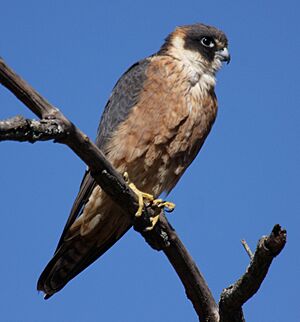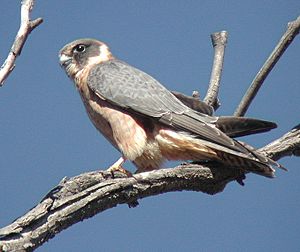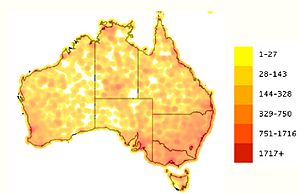Australian hobby facts for kids
Quick facts for kids Australian hobby |
|
|---|---|
 |
|
| Conservation status | |
| Scientific classification | |
| Genus: |
Falco
|
| Species: |
longipennis
|
The Australian hobby (Falco longipennis) is a small, fast falcon found across Australia. People also call it the little falcon. It's one of six types of falcons living in Australia. This bird of prey is mostly active during the day. Its scientific name, longipennis, means "long wings," which describes its long flight feathers. You can find Australian hobbies in Australia and nearby countries. Some even travel to islands like Indonesia and New Guinea.
Contents
What is an Australian Hobby?
Family Tree of the Australian Hobby
The Australian hobby belongs to the Falconidae family, which includes all falcons. Scientists group falcons into different types. These include kestrels, merlins, and peregrine falcons. Hobbies are a special group within this falcon family.
Different Kinds of Australian Hobbies
There are three main types, or subspecies, of the Australian hobby:
- Falco longipennis longipennis: This was first described by William Swainson in 1838.
- Falco longipennis hanieli: This type is a bit smaller and lighter in color underneath. It was identified in 1914.
- Falco longipennis murchisonianus: This one has lighter blue-grey feathers on its back. It also has a dull blackish head and lighter reddish-brown feathers below. This type was named in 1912.
The Australian hobby is related to other hobbies around the world. For example, it's quite similar to the Eurasian hobby. That bird lives in Europe and Asia and flies to Africa for winter.
What Does the Australian Hobby Look Like?
The Australian hobby is smaller than many other falcons. It has a slim body and long, narrow wings. Its feather colors can change based on if it's a male or female, its age, and where it lives. Birds in wet places might be darker, while those in dry areas are lighter.
Most hobbies have a black cap on their head and a black "mask" around their eyes. They also have a whitish forehead and a white half-collar. Their belly feathers can be blue-grey or reddish-brown, often with darker streaks. Adult hobbies have a pale yellowish-grey cere (the fleshy part above the beak). Their eye rings are pale blue, eyes are brown, and feet are dull yellow.
Female hobbies are a bit bigger than males. Females are about 34 to 35.5 centimeters long. Males are usually 30 to 32 centimeters long. Their wingspan can be between 66 and 87 centimeters.
Sometimes, people confuse the Australian hobby with the peregrine falcon. However, the hobby is thinner and has longer, more slender wings. It also flies a bit differently, not as powerfully as a peregrine.
Where Do Australian Hobbies Live?
You can find Australian hobbies all over mainland Australia. They also live on islands near the coast, like Lord Howe Island. However, they are not very common in Tasmania. Some hobbies travel to other countries, like Indonesia and New Guinea.
These birds like to live in open spaces. This includes open woodlands, areas near rivers, and even green parts of cities. They usually avoid cliffs or very steep rocky areas.
What Do Australian Hobbies Eat?
Australian hobbies are skilled hunters. They eat many different small animals. Their diet includes birds like the European starling and house sparrow. They also hunt crimson rosellas and silvereyes.
Scientists have noticed that hobbies usually avoid bigger or more dangerous birds. They also tend to stay away from birds that hide well in bushes. Besides birds, hobbies also eat bats that eat insects. They also enjoy a variety of insects. These includes beetles, cicadas, crickets, and grasshoppers.
How Australian Hobbies Behave
Flying High and Fast
Australian hobbies are usually found alone. They are very quick flyers. They beat their wings rapidly and fan their tail when hovering in the air. When gliding, their wings are flat or slightly drooped. Their flight is often low and fast, weaving through trees and open areas.
If another bird of prey, like a little eagle, comes too close, hobbies will defend their territory. They soar and circle high in the sky to scare them away. They might even dive at other birds, either perched or flying.
Hunting Skills
Hobbies are excellent hunters. They often hunt at dawn or dusk, but also during the day. Sometimes, they even hunt at night under artificial lights. They can catch their prey in mid-air. They might attack from a perch or fly quickly through tree branches.
They are very agile when chasing prey. They attack fleeing birds in a series of short shallow dives. They have also been seen using sneaky approaches. They fly hidden behind dunes or trees to surprise shorebirds. While they can bother larger birds, they don't usually kill them. Because they eat many insects, their prey is often quite small compared to their own body size.
Reproduction and Life Cycle
Australian hobbies usually nest between August and January. They don't build their own nests. Instead, they take over old stick nests built by other large birds of prey. The female lays three to four eggs. These eggs have many blotches. The parents take turns sitting on the eggs for about 35 days until they hatch.
Most often, two or three young birds successfully hatch. The young hobbies stay with their parents for up to three months. After that, they fly off on their own or migrate to new places. One young hobby, tagged in Canberra, was found 29 days later in Brisbane. That's about 1000 kilometers away!
Both male and female hobbies share the job of keeping the eggs warm. However, after the chicks hatch, the female mostly feeds them. The male hunts more often to bring food for the female and the chicks. They bring food to the nest about every three hours, with a longer break in the middle of the day.
Hobby Calls and Sounds
Australian hobbies make different sounds. When they feel threatened, they might make a "trill-type" sound. Their most common call is a "harmonic vocalization." They use this sound to defend their territory or to mob (harass) other birds.
During nesting season, adults use two main calls. One is a fast, chattering "Kee-Kee-Kee-Kee-Kee." The male makes this sound when bringing food to the nest. Both parents use it as an alarm call. They also use it when mobbing other birds or choosing a nest. The second call sounds like a squeaky chittering and ticking. This call is used when they are showing who's in charge or asking for food.
Young hobbies make a whining sound when they want food. When they are alarmed or excited, they make a chattering "kee-kee-kee..." sound. Hobby calls are similar to the male peregrine falcon's calls, but higher pitched. They also have alarm calls similar to the Nankeen kestrel.
Protecting the Australian Hobby
Conservation Status
The International Union for Conservation of Nature (IUCN) keeps track of animal populations. They consider the Australian hobby a species of "least concern." This means their numbers are currently stable and healthy.
The hobby is also listed on Appendix II of CITES. CITES is an international agreement about wildlife trade. Appendix II means that while the hobby is not currently endangered, its trade needs to be carefully watched. This helps prevent it from becoming threatened in the future.
Past Challenges and Health Concerns
In the past, a chemical called DDT was used in farming. This chemical caused the eggshells of some falcons, including the Australian hobby, to become thinner. Thinner shells meant eggs sometimes broke during incubation. This led to a small drop in local hobby populations. However, it did not cause a widespread decline across all Australian hobbies.
Hobbies can also get a serious illness called columbid herpesvirus-1 (CoHV-1). This infection can make them very sick and even cause death. They often get this illness from eating rock pigeons that carry the disease.
See also
 In Spanish: Alcotán Australiano para niños
In Spanish: Alcotán Australiano para niños






